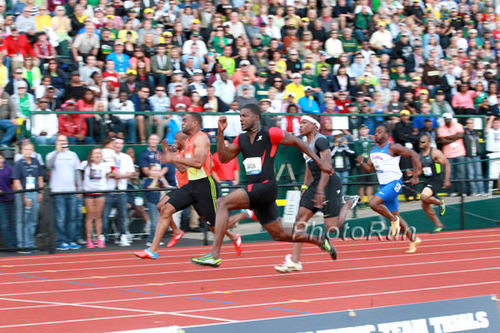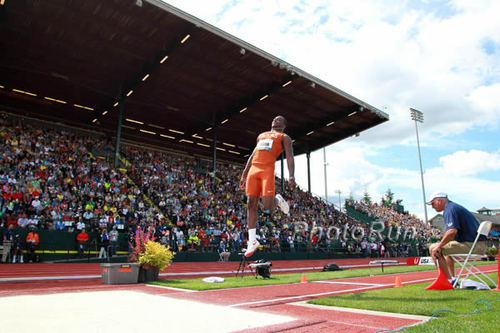James Dunaway is our media critic for the 2012 US Olympic Track & Field Trials. A man who has been writing about the each Trials since 1964, this is his first miss. So, we asked James to rate the TV one a scale of one to five stars, plus also add how he would improve the viewing.
At the end of the day, bad TV is not good for anyone, if you have comments on our coverage, email me at larry.eder@gmail.com.
photo by PhotoRun.net
The TV Trials Sunday, June 24, 2012 ***
On this first Sunday of the Trials, the program was short,
with only six sprint races (three of them finals) and four field events, all
finals.
The telecast began with a brief review of the tizzy created
by the dead heat for third place in Saturday’s women’s 100-meter final between
Allyson Felix and Jeneba Tarmoh, who coincidentally are training partners and
presumably friends. Tom Hammond surprised me by saying that “the photo-finish
has left a trip to London in the balance” for one of the two, since whichever
one finally ends up fourth will almost certainly be selected as a member of the
4×100 relay pool — how could USATF or USOC leave her off?
Ato Boldon had the proper answer to the problem – a run-off,
not only the fairest way, but also the traditional way all ties which cannot be
allowed to stand in have been decided since track and field became an organized
sport in the 1860s.
The biggest chunk of the one-hour telecast was devoted –
quite properly – to the semifinals and final of the men’s 100 meters. As was
done yesterday, the time and attention before each race was focused on only
seven of the 21 semifinalists. I will concede that all seven made the final –
which is very good predicting on the part of Ato and Company, but, I submit,
not good reporting. There was plenty of time to introduce each starter and tell
the viewer about him, and then zero in on the “ones to watch.” NBC can
do both, and should. We’re here to watch the race – all seven or eight lanes.
The 100 final coverage was just about perfect. We all knew
about Walter Dix, and we all knew that the race was likely to be Gatlin vs.
Gay, so one must admit that the system worked. It would have been nice if there could have been a bit more information
about Ryan Bailey after the race.
Both 400-meter finals were well-covered. The race calls were
excellent and accurate (calling 400 races is very difficult to do well). Again the introductions were focused on the favorites, and the picks were very good. By
the way, in one pre-race shot, Sanya Richards-Ross was shown pulling on her striped “arm socks.” How
come nobody asked her about those “socks?”
The four field events finals didn’t get much attention at
all. We saw four or five women’s vaults, three men’s shot puts, only one or two
men’s long jumps, and three women’s discus throws. Lots of good stories there
if TV could follow the competition for us – like high schooler Shelbi Vaughn,
who took fourth in the women’s discus with her second national high school
record of the meet., or the back-and-forth battle between Marquise Goodwin and
Will Claye in the long jump.
I know it’s virtually impossible to cover field events in a
tightly controlled time frame, but by the end of three rounds in the men’s long
jump, it was obvious that Goodwin and Claye were having an exciting
competition, and it would have been nice if the producers could have cut away just for those six jumps? Dwight would’ve
had no trouble in conveying the excitement, setting the scene and calling the
jumps, and then a throw back
to Tom and Ato upstairs. That could have been super; these two kids are tigers!
There’s an immense amount of drama in the field events – and
NBC and Stones captured a moment of it in Jenn Suhr’s two jumps. If NBC would
look for opportunities for cutaways – both high jumps, both triple jumps, for
example – I believe they could add a lot of excitement. And isn’t that what it’s
all about? I’m not saying it’s easy, but you won’t find those opportunities
unless you’re looking for them.
Speaking of cutaways, there were two more feature segments,
one called “Behind the Wall,” about what goes on behind the scenes as the
athletes get ready to compete or recover after competing — massage tables, et
cetera — the other “Processing” which showed athletes who
have made the team signing forms, being issued various goodies, and being
lectured about their behavior on the Great Olympic Stage. I don’t think they
added a bit of interest to the production.
In fact, IMNHO, the time would be better spent showing more
field events. Much better.
Author

Larry Eder has had a 52-year involvement in the sport of athletics. Larry has experienced the sport as an athlete, coach, magazine publisher, and now, journalist and blogger. His first article, on Don Bowden, America's first sub-4 minute miler, was published in RW in 1983. Larry has published several magazines on athletics, from American Athletics to the U.S. version of Spikes magazine. He currently manages the content and marketing development of the RunningNetwork, The Shoe Addicts, and RunBlogRun. Of RunBlogRun, his daily pilgrimage with the sport, Larry says: "I have to admit, I love traveling to far away meets, writing about the sport I love, and the athletes I respect, for my readers at runblogrun.com, the most of anything I have ever done, except, maybe running itself." Also does some updates for BBC Sports at key events, which he truly enjoys. Theme song: Greg Allman, " I'm no Angel."
View all posts






















